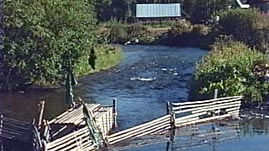Teachers' Domain - Digital Media for the Classroom and Professional Development
User: Preview

Source: Arctic Athabaskan Council
In this video adapted from the Arctic Athabaskan Council, learn about some specific effects of climate change on the subsistence lifestyle of the Athabaskan people. See some of the consequences of the movement of animals and vegetation from more temperate climates into the Arctic region. Hear firsthand accounts about changes in the salmon harvest and how the decline of salmon affects the villages and people.
The Athabaskan* people, located primarily in Alaska and northwestern Canada, are a collection of many different indigenous groups that speak Athabaskan languages. While there are cultural variations among the different Athabaskan communities, they share a history of subsistence culture. Their traditional dependence on natural resources for food, clothing, and shelter are a significant part of their cultural identity and keep them closely connected to the land. In Alaska, Athabascan settlements are usually located along rivers in the interior of the state where they can harvest one of their primary resources—salmon.
Pacific salmon are harvested in the summer and fall when they return to the rivers, streams, and lakes to reproduce. Salmon are born in freshwater systems but migrate to the ocean for two to six years as they mature. When mature, they return to the same freshwater where they were born. During the migration upstream, males and females pair up. When they are ready to mate, the female prepares a spawning bed, called a redd, by sweeping her tail on a gravel bed. She deposits her eggs into the redd, and then the male fertilizes the eggs. The female then covers the eggs with clean gravel. The pair will repeat this process in several locations until the female has released all of her eggs. For most species of Pacific salmon, the mating pair dies within a few days of spawning. The eggs develop in the gravel until they hatch in the late winter or spring.
Warmer water temperatures and melting permafrost associated with increases in Arctic air temperature over the past few decades are threatening some populations of Pacific salmon. Salmon only thrive under certain conditions: they require cool water (which holds more dissolved oxygen) and clean gravel beds with good water flow (to supply oxygen to developing embryos). Melting permafrost makes the land more susceptible to erosion and therefore increases sediment in rivers, which can settle into the gravel and smother the eggs. Higher winter stream flows and flooding increase gravel movement, which can increase the mortality of eggs and juvenile salmon. In addition, warmer waters increase the likelihood that the fish could be infected by parasites and affected by new species moving north.
The decline in salmon populations in some areas in recent years represents the loss of a major food source for indigenous cultures that depend heavily on the salmon harvest. Declines in salmon populations also affect other species, including birds and mammals, which eat salmon eggs, juveniles, and adults. Furthermore, the decaying carcasses of salmon are a primary source of nutrients, such as phosphorus and nitrogen, which are essential in the health of local ecosystems.
* The spelling "Athabaskan" is used in this essay because the related media was adapted from the Arctic Athabaskan Council. “Athabaskan” generally refers to the broader community of indigenous people across Canada and Alaska. On March 20, 1997, the Tanana Chiefs Conference in Alaska adopted a resolution designating "Athabascan" as the correct spelling in Alaska.
 Loading Standards
Loading Standards Teachers' Domain is proud to be a Pathways portal to the National Science Digital Library.
Teachers' Domain is proud to be a Pathways portal to the National Science Digital Library.
